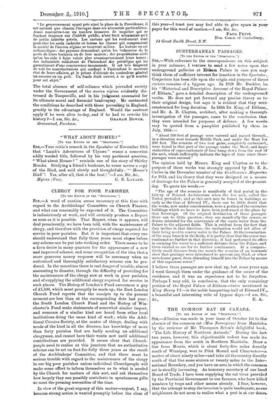SUBTERRANEAN PASSAGES.
[To THE EDITOR OF TEE " SPECTATOR.") Sin,—With reference to the correspondence on this subject in your columns, I venture to send a few notes upon the' underground galleries at BUJ:am Palace in case you may think them of sufficient interest for insertion in the Spectator.. Conjecture has been rife upon the origin and purpose of these; curious remains of a bygone age. In 1828 Mr. Buckler, ins his "Historical and Descriptive Account of the Royal Palace of Eltham," gave a detailed description of the undergrounst vaults. He does not put forward any precise theory as ti. their original design, but says it is evident that they were constructed for long duration. In 1834 Dr. King, of Eltliamr, and Mr. A. B. Clayton, architect, after making a thorough', investigation of the passages, came to the conclusion that they were intended for purposes of defence. A few words:. may be quoted from a pamphlet published by them in. July, 1834 :— " About 500 feet of passage were entered and passed through,. in a direction west towards Middle Park, and under the Moat for 200 feet. The remains of two iron gates, completely carbonized„ were found in that part of the passage under the Moat, and largo. stalactites of super-carbonate of lime hung down from the roof or the arch, which sufficiently indicate the 'awe of time since those. pe_qqsiges were entered."
The opinion held by Messrs. King and Clayton as to the purpose of these works was strongly opposed by Mr. E. S... Carlos in the December number of the Gentleman's Magazine- for 1834, and his theory that they were designed as a meana of drainage for the Palace is generally accepted at the present day. To quote his words :—
"The age of the remains is manifestly of that period in thn - history of Pointed Architecture when the low arch, called the- Tudor, prevailed ; and as this arch may be found in buildings an
early as the time of Edward IV., there can be little doubt that the works, now under consideration, were a portion of the extensivo buildings which we know to have been performed at the place by that Sovereign. Of the original destination of these passages there can be little question ; they are manifestly the sewers, or" drains, intended for the conveyance of the waste water from the- Palace to the adjacent fields. This is evident from the fact that... they incline in that direction ; the inclination would not allow of their being used to convey water to the Palace. At the termination of the main branch in the fields, it is pretty clear that the sower was continued no further in that direction ; it had performed its office- in carrying the water to a sufficient distance from the 'Palace, and there existed no use for its further continuance. At a compara- tively small distance from the mouth the remains of an ironwork' shew that gratings were introduced to prevent any thief, or other unwelcome guest, from obtruding himself into the Palace by means of this capacious sewer."
I believe these passages are now shut up, bat some years aggc. I went through them under the guidance of the owner of thet residence, and it was an experience not to be forgotten. Perhaps I may add, in conclusion, that the only remaining, portion of the Royal Palace of_Eltham—twice mentioned in King Henry VI.—is the noble banqueting-hall of Edward IIT.„ a beautiful and interesting relic of bygone days.—I am, Sir,
E. A..










































































 Previous page
Previous page